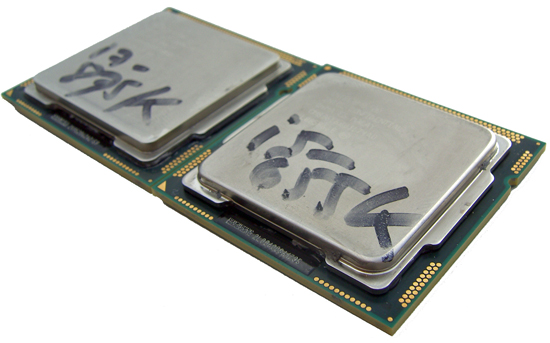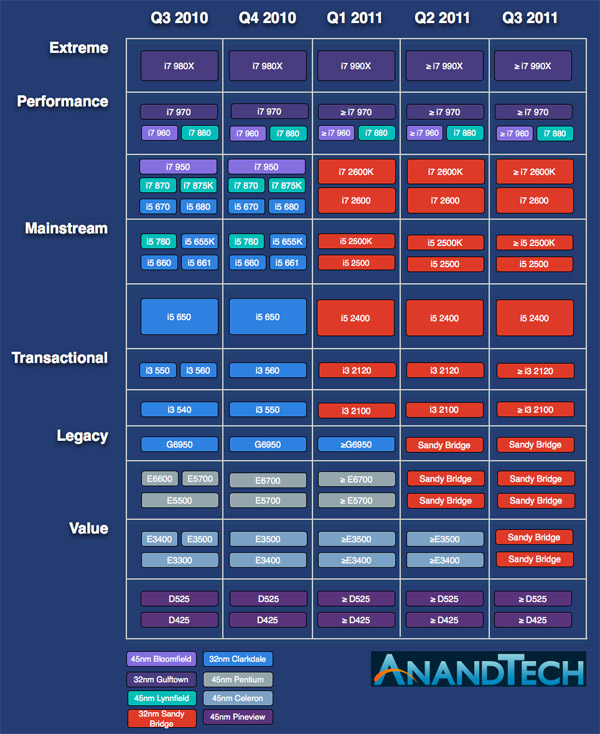Intel's Sandy Bridge Architecture Exposed
by Anand Lal Shimpi on September 14, 2010 4:10 AM EST- Posted in
- CPUs
- Intel
- Sandy Bridge
Multiplier-only Overclocking
There's no new information on Sandy Bridge overclocking at this point (although it's looking increasingly likely that there will be a reasonably priced K-series SKU for those users who want the flexibility to overclock without spending $1000). I've included the overclocking text and roadmap from our Sandy Bridge Preview below if you're interested in seeing what Intel has planned.
It wasn’t until the Pentium II that Intel started shipping multiplier locked CPUs. Before then you could set the multiplier on your CPU to anything that was supported by the line, and if you had a good chip and good enough cooling you just overclocked your processor. Intel’s policies changed once remarking, the process of relabeling and reselling a lower spec CPU as a higher one, started to take off.
While multipliers were locked, Intel left FSB overclocking open. That would be an end user or system integrator decision and not something that could be done when selling an individual CPU. However, ever since before the Pentium III Intel had aspirations of shipping fully locked CPUs. The power of the enthusiast community generally kept Intel from exploring such avenues, but we live in different times today.
Two things have changed Intel’s feelings on the topic. First and foremost is the advent of Turbo Boost. So long as Intel doesn’t artificially limit turbo modes, we now have the ability to run CPUs at whatever clock speed they can run at without exceeding thermal or current limits. We saw the first really exciting Turbo with Lynnfield, and Sandy Bridge is going to expand on that as well. On the flip side, Intel has used Turbo as a marketing differentiator between parts so there’s still a need to overclock.
The second major change within Intel is the willingness to directly address the enthusiast community with unlocked K-series SKUs. We saw this recently with the Core i7 875K and Core i5 655K parts that ship fully unlocked for the overclocking community.

The K-series SKUs, these will be more important with Sandy Bridge
With Sandy Bridge, Intel integrated the clock generator, usually present on the motherboard, onto the 6-series chipset die. While BCLK is adjustable on current Core iX processors, with Sandy Bridge it’s mostly locked at 100MHz. There will be some wiggle room as far as I can tell, but it’s not going to be much. Overclocking, as we know it, is dead.
Well, not exactly.
Intel makes three concessions.
First and foremost we have the K-series parts. These will be fully unlocked, supporting multipliers up to 57x. Sandy Bridge should have more attractive K SKUs than what we’ve seen to date. The Core i7 2600 and 2500 will both be available as a K-edition. The former should be priced around $562 and the latter at $205 if we go off of current pricing.
Secondly, some regular Sandy Bridge processors will have partially unlocked multipliers. The idea is that you take your highest turbo multiplier, add a few more bins on top of that, and that’ll be your maximum multiplier. It gives some overclocking headroom, but not limitless. Intel is still working out the details for how far you can go with these partially unlocked parts, but I’ve chimed in with my opinion and hopefully we’ll see something reasonable come from the company. I am hopeful that these partially unlocked parts will have enough multipliers available to make for decent overclocks.
Finally, if you focus on multiplier-only overclocking you lose the ability to increase memory bandwidth as you increase CPU clock speed. The faster your CPU, the more data it needs and thus the faster your memory subsystem needs to be in order to scale well. As a result, on P67 motherboards you’ll be able to adjust your memory ratios to support up to DDR3-2133.
Personally, I’d love nothing more than for everything to ship unlocked. The realities of Intel’s business apparently prevent that, so we’re left with something that could either be a non-issue or just horrible.
If the K-series parts are priced appropriately, which at first indication it seems they will be, then this will be a non-issue for a portion of the enthusiast market. You’ll pay the same amount for your Core i7 2500K as you would for a Core i5 750 and you’ll have the same overclocking potential.
Regardless of how they’re priced, what this is sure to hurt is the ability to buy a low end part like the Core i3 530 and overclock the crap out of it. What Intel decides to do with the available multiplier headroom on parts further down the stack is unknown at this point. If Intel wanted to, it could pick exciting parts at lower price points, give them a few more bins of overclocking headroom and compete in a more targeted way with AMD offerings at similar price points. A benevolent Intel would allow enough headroom as the parts can reliably hit with air cooling.
The potential for this to all go very wrong is there. I’m going to reserve final judgment until I get a better idea for what the Sandy Bridge family is going to look like.











62 Comments
View All Comments
FXi - Tuesday, September 14, 2010 - link
Only thing I am saddened by is that hybrid graphics apparently won't be "working" on the mobile high end chipset with the dual pci-e x8 lanes. It's extremely nice to have 2x a good modern mobile GPU, but still be able to switch to the Intel built in GPU when you want longer battery life on the road.That ability, in the 2920 was something I was truly hoping for.
The rest of its abilities are quite nice and very welcome. USB 3 really is something to be sure they didn't miss. But otherwise kudos Intel.
Drazick - Tuesday, September 14, 2010 - link
Anand, few questions with your permission:I wonder If we could use a Discrete Graphics Card and enable the Media Engine.
What about the DMI bus, Hasn't it become a bottleneck with SSD Drives and USB3?
Does Intel have planes to address it?
Thanks.
EricZBA - Tuesday, September 14, 2010 - link
Someone please release a decent 13.3 inch laptop using Sandy Bridge please.bitcrazed - Tuesday, September 14, 2010 - link
I have a sneaking suspicion that Intel will be at the core of Apple's next laptop platform refresh with both SandyBridge and LightPeak.Apple's MacBook lineup is starting to feel a little pressure from the other PC laptop vendors who are starting to produce some nicely designed tin and will need to stay current in order to continue to sell their products at such high premiums.
I'm imagining the next MacBook Pro lineup to offer 13" MBP's running i3 2120's and the 15" and 17" models running i5 2400/2500's or i7 2600's.
Apple already have their own dynamic integrated/discrete GPU switching technology (as do nVidia) and can make even better use of SB's integrated GPU augmented by a modest discrete GPU to deliver the performance that most users need but with much reduced power drain.
So how to differentiate themselves? LightPeak. Apple was the instigator of LightPeak to start with and Intel claimed at CES 2010 that it'd appear around a year later. That's next spring.
One thing's for sure: 2011 is going to be a VERY interesting year for new laptop and desktop devices :)
name99 - Tuesday, September 14, 2010 - link
LightPeak WITHOUT USB3 will go over like a lead zeppelin.There are already plenty of USB3 peripherals available. I have never in my life seen a LightPeak peripheral, or even a review or sneak peek of one. Light Peak is coming, but I'm not sure that 2011 is its year.
The rate at which CPU speeds now increases is low enough that very few buyers feel any sort of pressure to upgrade the machine they bough 3 years ago. Apple can't deal with that by simply offering new iMacs and MacBooks with the newest Intel offering, since no normal person is much excited by another 10% CPU boost.
They have done an adequate job of dealing with this so far by boosting battery life, something (some) portable users do care about.
They have done a mixed job of making more cores, hyperthreading and better GPUs a reason to upgrade. We have some low-level infrastructure in Snow Leopard, but we have fsckall user level apps that take advantage of this. Where is the multi-threaded Safari? Where is the iTunes that utilizes multiple cores, and the GPU for transcoding audio? Does FileVault use AES-NI --- apparently not.
But Apple has done an truly astonishingly lousy job of tracking the one remaining piece of obvious slowness --- IO. Still no TRIM, still no eSATA, still no USB3.
My point is that I don't know the Apple politics, but I do know that they are doing a very very bad job of shipping machines that compel one to upgrade. There is no need for me to upgrade my 3+yr old Penryn iMac, for example --- I'd get a replacement with more cores (not used by any of my software), a better GPU (but what I have plays video just fine), and most importantly, NO FASTER IO.
Adding LightPeak to this mix without USB3 is not going to help any. People are still going to hold off on upgrades until USB3 is available, and no-one is going to rush to buy a LightPeak system so that they can then NOT run any of the many unavailable LightPeak peripherals on the shelves at Fry's.
NaN42 - Tuesday, September 14, 2010 - link
On page 3: "Compared to an 8-core Bulldozer a 4-core Sandy Bridge has twice the 256-bit AVX throughput."WTF? 8*128 = 4*256. Based on the premise that the fp-scheduler of one Bulldozer module (two cores) can schedule e.g. one add and one mul avx-instruction per clock cycle, they have the same throughput. I think both architectures will have a delay for e.g. shuffling ymm-registers (compared to current xmm-instructions) because data has to be exchanged between different pipelines/ports (Hopefully the picture provided by Intel is correct). Perhaps the delay is smaller in Sandy Bridge cores. I expect some delays when one mixes floating-point and integer instructions on Sandy Bridge. (Currently I don't know, whether there exists a VEX prefix for xmm integer instructions. If there's no VEX prefix the delays will be great on both platforms.)
gvaley - Tuesday, September 14, 2010 - link
"...you get two 256-bit AVX operations per clock.""AMD sees AVX support in a different light than Intel. Bulldozer features two 128-bit SSE paths that can be combined for 256-bit AVX operations. "
So it's actually 8*256 = 4*2*256. At least this is how I see it.
NaN42 - Tuesday, September 14, 2010 - link
"So it's actually 8*256 = 4*2*256. At least this is how I see it. "Ok, my calculation was a bit different. 4*2*256 will be true, but only if you mix additions and multiplications. Whether AMD is 8*2*128 depends on the fp-scheduler (based on the premise that one SIMD unit consists of a fmul, fadd and fmisc unit or something similar)
NaN42 - Tuesday, September 14, 2010 - link
... one can do another floating point operation which goes through port 5, but the peak performance of additions and multiplications is more relevant in applications.Spacksack - Tuesday, September 14, 2010 - link
I think you are right. I would think bulldozer can manage the same theoreticakl throughput by issuing one combined FMA instruction (16 flop) / clock and module.More importantly Bulldozer will achieve hight throughput for all the existing SSE code by having two independent FMA units. I have no idea how Anand could make such a mistake.